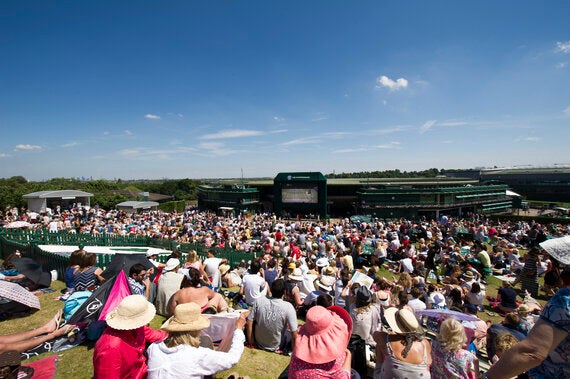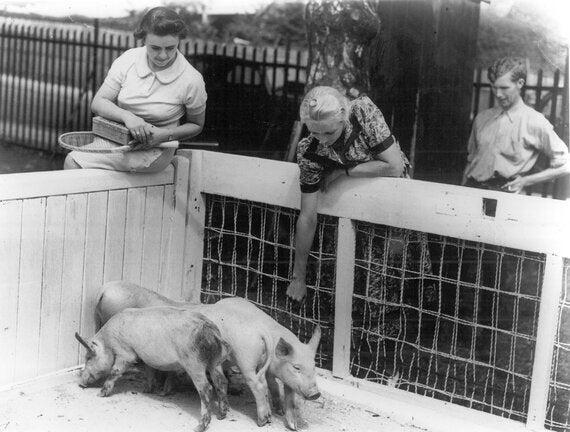
(c)AELTC/Chris Raphael
Stepping through the gates of Wimbledon this summer will be hundreds of thousands of people whose only common interest is, unsurprisingly, watching the tennis. Most won't really need to know that during their visit over 150,000 glasses of Pimm's will be downed or that 28,000 kilos of strawberries will be devoured - that's nearly three million of the little blighters in two weeks. Factor in the pizzas and pies, sandwiches and snacks and you have, almost unbelievably, the largest catering operation for any sporting event anywhere in Europe; bigger than motor racing, golf, football or cricket.
Wimbledon's loaded with facts, figures, snippets and secrets that accumulate, often with so little fanfare, that they tend to go unnoticed. Talking of food, it wasn't always so abundant. Between 1939 and the end of the Second World War, The Championships ceased and these manicured lawns - or at least the grounds - were given over to livestock. Poultry, pigs and sheep, were reared inside the grounds to feed the war effort and keep Britain 'in the game' against Hitler.

(c)WLTM
It was no secret a few years back that Wimbledon needed to expand its capacity. But the world was somewhat puzzled (aghast would be a better word) to learn that Wimbledon was going to be transposed to, wait for it, Basingstoke. Now, Basingstoke has its merits, but an affinity for tennis wasn't perhaps one of them. The fact is that moving to Basingstoke was never a realistic possibility and this 'open secret' was more to do with over-zealous reporting than anything else.
Wimbledon abounds with precious gems tucked away inside the books, ledgers, files, objects and minds of its members. And, like all precious gems, you have to do a little digging. Dig into the records and you'll find it's easily the world's largest annual broadcast event, getting an estimated 1.2billion viewers across 200 broadcast territories - and remember, this is a two week event - not a one-off cup final. It was also Wimbledon that set the world on the path to mass-market sports broadcasting way back in 1927 when The Championships was first aired on BBC radio. Of course, being Wimbledon, it insisted that commentators, watching from courtside, should only whisper into their microphones - not because they were disclosing secrets, but because nothing should be allowed to disturb the players' concentration.
Perhaps the biggest 'secret' sits unassumingly below ground level tucked away behind the Wimbledon Lawn Tennis Museum with nothing more than a discreet sign engraved upon its glass doors. This is the Kenneth Ritchie Wimbledon Library, a long standing reference facility that houses the largest collection of tennis related books, magazines, texts, guides, programmes and clippings in the world - bar none! Started by Honorary Librarian Alan Little in the 1970s, the Library's mandate is simple, to collect anything and everything ever written about tennis: fact or fiction. This includes some genuinely eclectic subjects, from tennis murder mysteries to mental self-help guides. Quaint old novels in musty hardback and glossy 70s paperbacks sit side by side on the rows of shelves, but don't search 'by author'. Intriguingly, Wimbledon classifies its collection first by country, starting with Argentina and ending with Zimbabwe, and then by date.

(c)AELTC/Javier Garcia
Assistant Librarian, Audrey Snell, can heave off of the Library's creaking shelves whole reams of date-ordered 'periodicals' (magazines to you and me) from around the world. There are huge bound volumes of World Tennis from the USA alongside Tennis Revue from the Netherlands, and plenty more besides, each revealing the fascinating trends and fashions, entertaining adverts and editorial pieces of world tennis.
Wimbledon's own press clippings are kept in yearly scrapbooks, standing on their shelves, erect and fully upright, dating back to 1927. In these epic tomes, evocative newspaper articles and photos in black and white have been assiduously clipped, snipped, glued and labelled just as you might expect from a keen hobbyist, instead of the world's largest tennis tournament. Open them up and a forgotten past of elegant players and grammatically perfect newspaper text transports you back in time. Indeed, the clippings hold such a mine of information that former players and visitors alike continually visit the library to check on some aspect of their past association with Wimbledon.
And then there are the books - little social time capsules of fact and fiction such as Death Serves An Ace by Helen Wills from 1939, or The Tennis Terror by Harold Sherman, 1932,
"A novel that captures the dashing spirit of the game".
In fact, everywhere you look you'll find surprising diversity, from Acing Depression by Cliff Richey to William Tilden's The Common Sense of Lawn Tennis written in 1924 - not to mention plenty of good old fashioned text books on, dare we say it, the secrets of playing better tennis.
